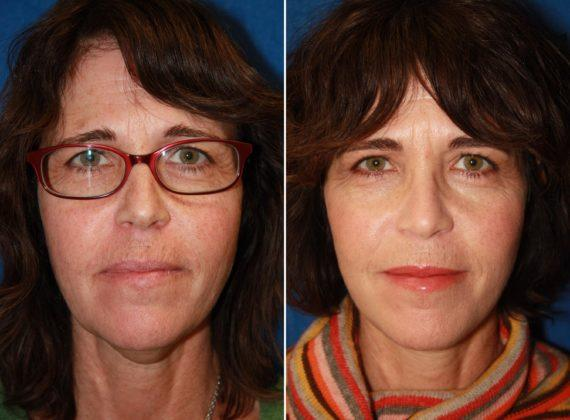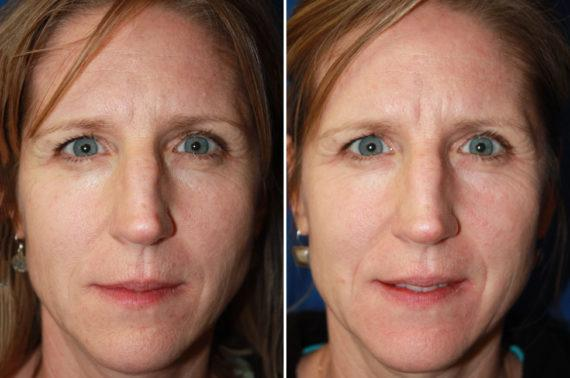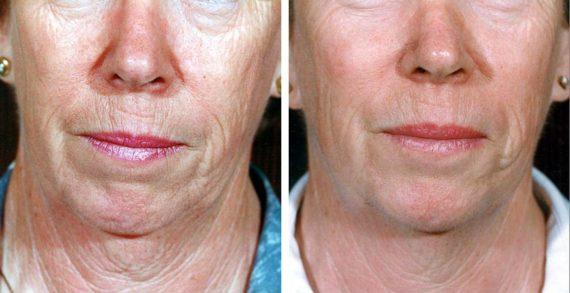
21 Sep 2023 | by Leonard Miller, MD, FACS, FRCS
What Is Neck Skin Aging?
Neck skin aging is a natural process that occurs over time. It is caused by a combination of factors such as genetic predisposition, lifestyle choices, environmental exposure, and age. Common signs of neck skin aging include wrinkles, sagging skin, discoloration, and dryness. As the neck ages, it loses firmness, elasticity, and volume leading to an overall aged appearance. To combat the effects of neck skin aging without surgery, several non-invasive treatments are available today including topical creams and serums, laser treatments, injectables like Botox or filler injections, and microneedling. These treatments can help reduce the appearance of wrinkles and fine lines while providing hydration to the delicate skin on the neck area. Additionally, lifestyle changes such as avoiding sun exposure and smoking can help to prevent further signs of aging from developing.
How to Prevent Neck Skin Aging?
The best way to prevent neck skin aging is to maintain a healthy lifestyle, practice good skin care habits, and protect the skin from sun damage. A healthy diet low in sugar and processed foods, high in antioxidants, and rich in healthy fats can help reduce inflammation that can lead to wrinkles. Additionally, drinking plenty of water throughout the day will keep your skin hydrated and limit dryness. Skin care products containing ingredients like retinoids and peptides can boost collagen production while also providing hydration. Sun protection is key when preventing signs of aging on the neck. Wearing sunscreen with an SPF of 30 or higher daily can help protect against wrinkles caused by UV damage. Finally, limiting alcohol consumption and quitting smoking can help prevent further signs of aging from developing in the neck area.
The Role of Collagen in Maintaining Skin Health
Collagen is essential for maintaining skin health, as it provides firmness and elasticity to the skin. A decrease in collagen production is one of the primary causes of wrinkles and sagging skin associated with aging. To maintain optimal skin health, you should increase collagen production through lifestyle changes, such as a healthy diet rich in antioxidants and anti-inflammatory foods, avoiding sun exposure, staying hydrated throughout the day, limiting alcohol consumption, and quitting smoking. Additionally, using topical creams and serums can help boost collagen production while providing hydration to the skin. Microneedling treatments can also effectively stimulate collagen growth in the neck area while reducing signs of aging. Finally, an individual can receive laser treatments to resurface the neck area by stimulating collagen production that leads to firmer and more youthful-looking skin.
Causes of Loose Skin on Neck Area
People with all skin types experience the common problem of loose skin on the neck area. The causes of this condition can vary but typically include a combination of genetics, lifestyle choices, and aging. A proper treatment plan for loose skin on the neck depends on the individual’s skin type and degree of skin laxity. Commonly used treatments for this condition range from topical creams to laser therapies that can help improve firmness and elasticity in the neck area. Additionally, injectables like Botox or filler injections can also be used to reduce wrinkles and sagging in this area. With the right treatment plan tailored to each individual’s needs, it is possible to improve the appearance of the neck without surgery.
Sun Exposure and Other Environmental Factors
Sun exposure can significantly contribute to the development of loose skin in the neck area. Direct sun exposure can cause premature aging, resulting in wrinkles and sagging skin. Sun spots may also appear as dark patches on the neck area due to long-term UV radiation damage. Skin tones play an important role in how much sun exposure one can safely sustain. Those with lighter skin tones are more likely to experience damage from UV radiation than those with darker skin tones. To prevent premature aging from sun exposure, you should wear sunscreen with at least SPF 30 daily, cover up with protective clothing or hats when outside for prolonged periods, and limit direct sun exposure.
Lifestyle Habits and Age-Related Changes
As we age, our skin begins to show signs of aging such as wrinkles, dryness, and sagging. Loose skin on the neck area is one of the most common signs of aging and can be caused by numerous factors including lifestyle habits, genetics, and environmental damage. Age spots, another common sign of aging on the neck area, are caused by UV radiation from too much sun exposure. To prevent premature aging of the neck area, you should practice healthy lifestyle habits such as avoiding smoking, limiting alcohol consumption, eating a balanced diet rich in antioxidants and healthy fats, drinking plenty of water throughout the day, exercising regularly, getting enough sleep each night, using sunscreen with an SPF 30 or higher daily when outside for prolonged periods, and protecting your skin from other environmental factors like wind or heat. Additionally, topical creams and serums containing retinoids or peptides can help increase collagen production while providing hydration to the skin. Finally, treatments such as microneedling or laser resurfacing can enhance collagen production to improve firmness and elasticity in this area.
Genetics and Ethnicity Factors
Genetics and ethnicity can play a role in the development of loose skin in the neck area. As we age, our bodies produce less collagen, which leads to wrinkles, sagging skin, and other signs of aging. Those with lighter skin tones are more likely to experience premature aging due to sun exposure than those with darker skin tones. Additionally, genetics can also contribute to the development of wrinkles and sagging skin in the neck area as different ethnicities tend to have different amounts of fat cells that provide support under the skin. To reduce these signs of aging, you should take care of your facial muscles and increase collagen production through healthy lifestyle habits such as eating a balanced diet rich in antioxidants, avoiding smoking and alcohol consumption, staying hydrated throughout the day, using sunscreen daily when outdoors, limiting direct sun exposure, and protecting your skin from environmental factors like wind or heat. Additionally, using creams containing retinoids or peptides can help boost collagen production while providing hydration to the skin. Finally, treatments such as microneedling or laser resurfacing can stimulate collagen growth leading to firmer and more youthful-looking skin.
See more patients »
What Is Collagen Production?
Collagen is a protein found in our skin and other connective tissues that keeps these tissues healthy, firm, and youthful. Collagen production naturally decreases with age, resulting in wrinkles and sagging skin. As we age, our bodies produce less collagen leading to wrinkles, dryness, and uneven skin tone.
Cosmetic surgery can help increase collagen production in the facial area. Facial cosmetic procedures like chemical peels or laser resurfacing can stimulate collagen production by removing dead skin cells and revealing new layers of healthy skin cells beneath. Stimulated collagen production helps reduce wrinkles, sagging skin, and other signs of aging while giving the face a firmer and more even tone.
In addition to cosmetic surgery treatments, several non-surgical options can help boost the production of collagen in the face. Topical creams containing retinoids or peptides can help increase collagen production while providing hydration to the skin. Additionally, lifestyle habits such as eating a balanced diet rich in antioxidants, avoiding smoking and alcohol consumption, staying hydrated throughout the day, and using sunscreen daily when outdoors protect your skin from environmental factors like wind or heat can also help promote healthier-looking skin while boosting collagen levels.

Reasons for Low Collagen Production with Age
As we age, our bodies produce less collagen, which leads to wrinkles, sagging skin, and other signs of aging. Facial skin is most affected by aging as thinning of the epidermal layers decreases skin quality and reduces fat deposits in the neck area. The decrease in collagen production is due to a variety of factors such as genetics and environmental conditions. Sun exposure, smoking, poor diet, dehydration, and lack of exercise can all affect the amount of collagen produced by the body. Additionally, some medical conditions such as thyroid disease or diabetes can contribute to low collagen production.
Various treatments address these issues by boosting collagen production and increasing facial rejuvenation. Microneedling is an effective treatment for improving skin texture by stimulating new cell growth and increasing collagen production. Laser resurfacing helps reduce wrinkles and improve skin tone by removing layers of damaged skin cells while boosting natural collagen production in the face. Cosmetic treatments such as Botox or fillers can help correct volume loss in the neck area. Lastly, a good skincare routine with products that contain antioxidants can help repair damage from sun exposure while providing moisture to maintain healthy-looking skin over time.
Benefits of Increasing Collagen Levels in the Skin
Increasing collagen levels in the skin can help address a variety of skin conditions and concerns. Collagen is a protein found in our connective tissues that contributes to the strength and elasticity of our skin. As we age, our bodies produce less collagen, leading to wrinkles, sagging skin, and other signs of aging. Increasing collagen levels can help reduce wrinkles and improve overall facial rejuvenation.
Increasing collagen production helps firm up the neck muscles by providing better support for the underlying structure. This can also reduce jowls or creases in the chin area and can give your face a more youthful appearance. Additionally, increased collagen production helps hydrate the layers of skin while strengthening it against external damage from environmental factors like wind or heat. The improved hydration helps keep dryness at bay while improving the overall tone and texture of the skin.
Finally, increasing collagen levels can help protect against future signs of aging by providing an extra layer of protection against further sun damage or environmental factors that could affect your complexion over time. By boosting your body’s natural collagen production, you can maintain healthy-looking skin for longer, which will result in fewer fine lines and wrinkles as you age.

Non-Surgical Treatments for Neck Skin Rejuvenation
Non-surgical treatments for neck skin rejuvenation are becoming increasingly popular due to their effectiveness in reducing wrinkles, improving texture, and creating a more youthful appearance. These treatments can help improve the overall appearance of the neck by targeting common skin concerns such as wrinkles, sagging skin, age spots, and creepiness.
The most common non-surgical treatment options for neck skin rejuvenation include laser resurfacing and microneedling. Laser resurfacing effectively treats wrinkles and sun damage on the face and neck. This procedure uses tiny beams of light energy to remove damaged layers of skin cells while boosting natural collagen production. Microneedling is another popular option that involves tiny needles that create microscopic channels in the skin’s surface to stimulate collagen production while also increasing the cell turnover rate.
Other non-invasive treatments such as chemical peels or facials can help exfoliate dead skin cells while providing hydration to the underlying layers of skin. Additionally, topical creams containing retinoids or peptides can increase collagen production while hydrating the face. Lastly, lifestyle habits such as eating a balanced diet rich in antioxidants, avoiding smoking, and alcohol consumption can rejuvenate the skin.

Radiofrequency microneedling
Radiofrequency microneedling is a non-surgical treatment for neck skin rejuvenation that can address signs of aging, wrinkles, and sun damage. This procedure uses tiny needles to create microscopic injuries in the skin’s surface that stimulate collagen production and cell turnover. Additionally, RF energy is released from the microneedling device to target the deeper layers of the skin. This helps tighten and firm up the underlying muscles while providing an overall smoother appearance.
The whole process usually takes around 30 minutes per session with no downtime required afterward. After each session, patients may experience some mild redness or flushing, which should resolve on its own within a few hours. Patients will see some results within days after the first session with full results appearing in about 4 weeks following a series of treatments.
Microneedling effectively improves neck skin rejuvenation without surgery and can reduce wrinkles, sagging skin, age spots, crepey neck skin, and other signs of aging. Only a qualified medical professional should perform this treatment as it requires specialized equipment and training for safe use.
Fat Transfer to the Neck
Fat transfer to the neck is an increasingly popular procedure for improving the appearance of aging skin. It involves transferring fat from another area of the body, such as the abdomen or thighs, and injecting it into areas of the neck that are sagging or have lost elasticity over time. The fat cells act as fillers to help restore fullness and volume while also providing a natural lifting effect to improve wrinkles and creases in the skin.
Fat transfer can help tighten and rejuvenate the neck by creating a smoother surface with improved contours. Additionally, this procedure encourages natural healing processes within your own body by using your cells, which helps reduce any risk of complications or adverse reactions. Lastly, fat transfer can provide long-lasting results compared with other non-surgical treatments due to its ability to stimulate collagen production, which leads to a tightened and more youthful appearance over time.
Only a qualified plastic surgeon should perform fat transfer as it requires specialized knowledge and experience for safe use. Your surgeon will use advanced techniques such as ultrasound imaging during the procedure to ensure that each injection is correctly placed for maximum effectiveness.
Topical Products
Topical products can be an effective and non-invasive way to reduce signs of aging in the neck. Products such as serums, creams, and masks containing active ingredients like vitamin A (retinol), antioxidants, peptides, and hyaluronic acid can help boost collagen production while providing hydration to the skin. These products help increase cell turnover rate and promote elasticity resulting in a more youthful appearance. For best results, you should use these products consistently for at least 4 weeks to see lasting results. Additionally, you should use sunscreen regularly to protect your skin from further sun damage and premature aging.
Additional Treatments: Botox, Dermal Fillers, and Fractional Laser Treatments
Botox, dermal fillers, and fractional laser treatments are among the most popular non-surgical treatments for addressing neck aging. Botox injections can help reduce wrinkles and fine lines on the neck while dermal fillers are ideal for adding volume to sagging skin and smoothing out crepey areas. Fractional laser treatments penetrate deep into the skin to improve texture and provide a more even tone, resulting in a healthier-looking neck overall. These treatments work best when used in combination as they can be tailored to target specific concerns such as age spots or crepey skin. Additionally, injectable fillers can provide long-lasting results with minimal downtime required following treatment. All of these options offer an effective way to rejuvenate your neck without surgery and can help restore a more youthful look.
Cosmetic Procedures to Achieve a Youthful Appearance of the Neck
Cosmetic procedures can effectively achieve a youthful appearance of the neck. Depending on your aesthetic goals, you may need a combination of treatment sessions to achieve optimal results. For example, collagen induction therapy (CIT) is a treatment that uses microneedles to stimulate collagen production and help reduce wrinkles and creases in the neck area. This type of treatment requires several sessions for the best results but can provide long-lasting improvements with minimal downtime. In addition to CIT, a skincare routine that includes using topical products such as serums, creams, masks, and sunscreen regularly can help improve overall skin health. For those who want more immediate results from their neck rejuvenation treatments, single-session therapies such as Botox injections or dermal fillers can provide noticeable improvements without surgery or extended recovery time. By combining multiple treatments tailored to individual needs, you can achieve healthier skin and an improved appearance of the neck.
